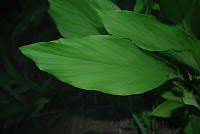There was once a time when I was at the top level in corporate world. There was once a time when my time was just filled with work commitments. There was once a time when I was jet-setting all over the place. There was once a time when I was making the big bucks. Now I am a simple farmer producing food without the use of chemical pesticides, fertilizers or herbicides. And guess what, I am happy :).
All my previous experiences have been useful in my current vocation. To debunk some myths, farming today is not for the faint-hearted, illiterate, no-other option person. It requires you to have lots of "professional" skills. Among them are planning, time management, project management, budgeting, accounting, communications, personnel management and marketing. Apart from that you need knowledge of Physics, Chemistry, Biology, Botany, Mathematics - to name a few. so, if you think that anyone can do farming, think again. I have great respect for the successful farmers that I know - they have an abundance of knowledge in a wide-array of areas and not having an MBA does not detract them from success, though quite a few do have MBA. Surprised? Don't be, this is the new breed of farmers.

At the top of the list, is commitment as there is no off-days in farming as you are dealing with life forms that need tending daily. Management of the daily activities is prime or it will result in low yield or low quality produce. Each item that you plan to produce can be seen as a project on its own with its own timeline, resource requirements, costs, sales and marketing tasks. There is no such thing as letting nature take its course with minimal effort from the farmer.

For example, take producing bananas as a project. To have high quality and high yield, you cannot just plant the plant and let it grow on its own and wait for the plant to fruit - so when someone makes an ignorant statement
like "Bananas should be cheap, you just plant and wait for it to fruit. You do not have to do much.", they should try it. You need to maintain the plants, ensuring sufficient water and good quality soil with good nutrients. Periodic maintanance of the plant, removing old leaves and checking the health of the plant, is a must. You need to watch out for pests (human and animals) and also for sickness. All this requires knowledge, resources and management. A good yield per plant is around 15-20kg. SHL produces and direct sell its bananas to preserve revenue and reduce money-drain. What do I mean by money-drain - well if we sell to another party we get RM 1.00 per kg but if we sell direct, we get RM 3.00 per kg albeit there is the additional cost of sales. However, the net result is better revenue for the farm. By selling it ourselves, it also gives us the control over the quality of the produce - we practice JIT - just in time - so the bananas are harvested and sold at its prime.

Producing vegetables is also another big continuous project. Going natural introduces added challenges. The easy way would be to just use chemical pesticides and herbicides and I can get rid of these pests easily and quickly and produce beautiful-looking vegetable with a lot less effort. However, in line with my principle that I only sell what I want to eat, this is not an option. This project lends itself to research of alternative ways of keeping pests to a minumum whilst providing necessary nutrients for quality vegetable growth. While it may be more time-consuming, it is worth the result - fresh, tasty, nutritious vegetables without traces of harmful chemicals. Some may argue that it is only a trace so what is the big deal. To this I say, the choice is yours. There are so many things that takes years of consumption before the effect is seen so I leave it to you.

Time management and prioritization is important. The big benefit now is that my family is first and I arrange what I need to do around my family and my needs and not the corporate agenda. It is all about scheduling what I
need to get done at the farm against my priority. Having good staff is also important so that we can work as a team together, living a life and not living for work. With all the chores at the farm, I do not need to find a gym - I can get my cardio, weight and strength training as well overall workout at the farm without thinking of it as task I need to do but incorporated into my lifestyle. I also do not worry about retirement as it is my farm and I can continue to be active and have quality of life without having to think what I want to do after retirement if I was still in the corporate world. There is stress because of standards that I place on myself and due to unexpected issues arising but it can be managed.
So, the next time that you look down on a farmer, realize that this person has probably the equivalent or more skills that you as an engineer, doctor or any of the other "professionals". We, the farmers, who produce food for you should be treated with respect :)



.JPG)













